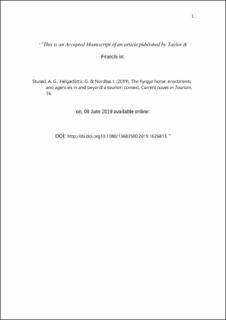The Kyrgyz horse: enactments and agencies in and beyond a tourism context
Peer reviewed, Journal article
Accepted version
Permanent lenke
https://hdl.handle.net/11250/2647626Utgivelsesdato
2019Metadata
Vis full innførselSamlinger
- Institutt for økonomi og it [161]
- Publikasjoner fra CRIStin [3623]
Sammendrag
The horse has a strong cultural and historical importance in Kyrgyzstan. With a mountainous topography, the rural areas of this Central Asian country are best accessed by horse. Among all the tourism experiences Kyrgyzstan can offer, horse trekking has become one of the most popular. The article discusses horse–human relations in post-Soviet Kyrgyzstan. The article will show how the Kyrgyz horse is enacted in multiple discourses and practices related to tourism, some of which converge, while others are in conflict. The article is supported by a political ecology approach, holding that nature is socially and politically constructed, as well as ANT/post-humanism approaches to tourism studies, which bring attention to non-human agency. We find that the multiple enactments of the Kyrgyz horse, the brand, the battle horse, the breed, the beshbarmak, and the best friend, derive from the horse’s multiple agencies, which give the horse its important position in Kyrgyz culture and society. However, the branding of the Kyrgyz horse as a ‘unique’ selling point in tourism development fails to acknowledge the complex human-animal relation by down-playing horse husbandry practices that are in conflict with tourism.
